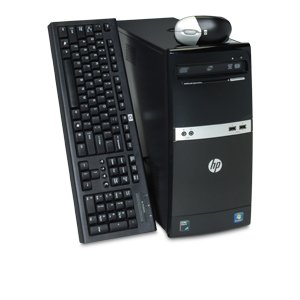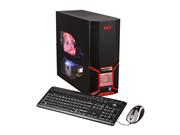Back To School Technology Buyer's Guide
by Zach Throckmorton on August 4, 2011 8:55 PM ESTRetail desktops
Component for component, retail desktops rarely offer as much value or flexibility as a comparable DIY desktop, especially if as a student you have access to heavily discounted OS licenses. However, retail desktops are often a good choice if the primary user is not especially tech-savvy. Retail desktops come with technical support and straightforward warranties. That is, they're potentially less of a headache in case something goes awry. When shopping for retail desktops, it is very important to shop around for remarkable sales. That said, we outline below what you can typically expect at four different price points.
Less than $300

At $300, retail desktops typically feature previous-generation CPUs, less than 4GB of memory, smaller hard drives, and integrated (i.e. non-gaming) graphics. That said, these very inexpensive PCs are still up to basic productivity tasks like web browsing and document creation, as well as sound and video playback. The Acer Veriton VX275-UD5800W is an example of such a computer. Its dual-core Intel Pentium E5800 processor is based on a CPU architecture that is now two generations old, it has 2GB of RAM, and a 320GB hard drive. It's an attractive choice for college students because it's tiny—16" deep by 4" wide by 11" tall. Its 4" width is a small desk footprint; it could easily be placed on a typical dorm room desk while leaving plenty of room for other items. Considering the very low cost of RAM, upgrading it to a more comfortable 4GB would cost less than $15.
Around $400

At $400, give or take, retail desktops start having good enough hardware that you can get four years of basic usage from them. Budget current-generation processors, 4GB RAM, smaller hard drives, and integrated graphics are typical in this price range. HP's 505B has specifications similar to the AMD micro-ATX system outlined on the previous page. The most important difference is the HP's PSU is 300W, and like most retail computer PSUs, it's likely not even capable of supplying that much electricity. The weak PSU severely limits this system's expandability in terms of adding more hard drives or a GPU. Also, the HP case is not nearly as attractive as the Fractal Core 1000! That said, it's a solid value at just over $400.
Around $500

As a long-time computer enthusiast, it truly amazes me how much power can be purchased for $500 today. At $500, lower mid-range CPUs, more than adequate 6GB or 8GB of memory, and large hard drives abound, though these systems usually lack discrete GPUs (if you're not gaming, this does not matter). The Gateway DX4850-45u is exactly $500, has a quad core Intel Core i5 CPU, 6GB DDR3, and a 1TB hard drive. This system is respectably powerful today, and it will be very serviceable in four years. Its chassis also includes a few niceties like easily-accessible media card readers and more than typical USB ports. Its optical drive not only reads and writes CDs and DVDs, it can also read Blu-ray discs. WiFi is integrated. Unfortunately it also includes an anemic 300W PSU, so upgrading it with anything more powerful than a low-end gaming GPU will require upgrading the power supply as well.
Around $700

At $700, retail PCs typically contain higher mid-range processors, 8GB RAM, large hard drives, and begin to include decent gaming GPUs. You usually get better bang for the buck at this point if you get away from the Dell and HP systems, where there's a major premium for decent graphics cards, and that's what we've selected here. CyberpowerPC's Gamer Xtreme 1314 houses the very capable Intel Core i5-2500K CPU, 8GB memory, a 1TB hard drive, and an AMD Radeon HD 6670 GPU. AnandTech reviewed the 6670 a few months ago and found it to be capable of producing acceptable frame rates (i.e. 30FPS or higher) in most games at resolutions less than 1080p and medium settings. The 6670 is not an enthusiast gamer's card, but it's okay for casual gamers, or hardcore gamers who like older titles (think World of Warcraft). Unfortunately, its motherboard will not facilitate overclocking the Core i5-2500K. Note that as the cost of the retail PC has risen on this page, so has its performance discrepency with the comparable DIY system. The Intel Core i5-2500K-based PC on the previous page has an enthusiast gamer-grade GPU, an SSD, a more feature-rich and overclockable motherboard, an aftermarket CPU heatsink for better overclocking results, and a much higher quality power supply for less than $100 more than this retail PC.
Now that we've covered both build your own and pre-built systems, the next page looks at what you'll actually be looking at: monitors.










94 Comments
View All Comments
blueeyesm - Friday, August 5, 2011 - link
Sure, get a MacBook and discover that you overpaid for a computer that can't run a required application for your program.How do I know this? I work for a university where I have seen this time and again. As StormyParis said, you should try being what you do, not what you own.
Sure, install Parallels and Windows. But you need to pay for your copy of Windows. More money spent where it could have gone to books or food.
Portability became "key" due to a trend where it was "cool" to have something lightweight and you could take it with you. A convenience that was turned into necessity. Before that, students along just fine with desktops.
Dorms provide desk space, thus yes it DOES work. It is not 0 chance, nor retarded.
If you are worried about theft, get a Kensington cable lock and lock it all down.
antef - Saturday, August 6, 2011 - link
I only graduated undergrad in 2009, so definitely during a period where laptops were plenty affordable, yet I got through college just fine with only my gaming rig and no laptop. I even had a 5.1 sound system and lived in a super cramped, wedge-shaped room one year with a roommate. Yes it was crowded but completely fine. I never had a need for a laptop - they only distract you in class and a notebook and pen work fine for notes. I didn't go the library much as I found it no better a place to study than my own dorm or apartment, but when I did there were public computers available. If you need/want a desktop as I did, you can definitely save money by not having a laptop also if you don't need it. However, I realize most students love going to the library or coffee shops or whatever to do work, in which case you'll want one. Also, if you have no need for a desktop, the laptop is a better option because it's less of a hassle when moving.shellcrash - Saturday, August 6, 2011 - link
There is also a common denominator issue going on: not everyone is expected to have a laptop. If one is required, the prof borrows one from the IT department.I graduated in 2006 & laptops were affordable, but they have durability issues that show up when in frequent transportation or use. In random work meetings having a desk & environment designed for work is much better than trying to do serious work in a laid back coffee shop environment; I stopped using my laptop when I started using my Palm (or was it lol TI-89?) & flash drive effectively. It also didn't help that the fans on the laptop died and some keys stopped working on the keyboard.
The reviews didn't cover phones, although it is the 2nd most crucial instrument in college. Needs to be able to be backed up to computer and do fast assignment scheduling.
anishannayya - Monday, August 8, 2011 - link
75% (really closer to 50%) percent of my classmates didn't have to spend a dime for their computers.50% of my classmates aren't CS/Engineering majors.
The 20% of CS/Engineering majors that have a Mac inevitably end up having to install and use Windows.
The only Mac worth the money is the Air. For everything else, your better off with a Thinkpad.
Lastly, Macs look great, but durability is very important when you take your device everywhere.
And RE desktops: Many gamers bring their desktop.
Neo Elemental - Monday, August 15, 2011 - link
I had a desktop all the years I was in college. To some, having additional horsepower is a non-negotiable (think games). I did end up caving and getting a netbook in my senior year.I don't see how the desktop+netbook combo is any less feasible or attractive for someone at an equivalent price (except that not everyone can build their own desktop).
This isn't the site for those who are just going to get a Macbook because they can afford it. A majority of the things mentioned/reviewed on this site are focused towards desktops and non-Apple systems.
mfenn - Thursday, August 4, 2011 - link
You make a big deal about constrained space when you talk about the PC itself, but you seem to completely forget about it when you recommend dual monitors. A tower can easily be tucked under a bed or desk, a second 22" monitor cannot.Kaboose - Friday, August 5, 2011 - link
Wall mount :D(mnewsham)
Friendly0Fire - Thursday, August 4, 2011 - link
"And given the limitations of the 400W PSU, I wouldn't add a GPU that's more power-hungry than a Radeon HD 6970."Surely you meant a 6790? The 6970 isn't exactly sipping power.
Gigantopithecus - Thursday, August 4, 2011 - link
Nope, the 6970 is not exactly a power sipper, but at peak during gaming it draws less than 200W. The rest of the system at stock without more components added isn't going to draw more than another 120W or so, and that leaves 20%+ headroom on the PSU. The link to Bench I gave with that line shows the 6970 using 340W from the wall, and the Bench test platform is a more power-hungry system than the one in this guide. A friend of mine is rockin' a GTX 560 Ti (a slightly less power-hungry card than the 6970) with a mildly OC'd AMD PII X4 (a 125W CPU vs the 95W CPU in the guide), two fans, one HDD system on this same PSU with no issues. It's a good PSU.JarredWalton - Friday, August 5, 2011 - link
Well, I've run a single 5870 off of a 500W PSU, and power draw at the outlet never got about 380W. Accounting for efficiency, a 400W PSU should still handle a 6970, but you wouldn't want to load it up with other extras or extreme overclocking.